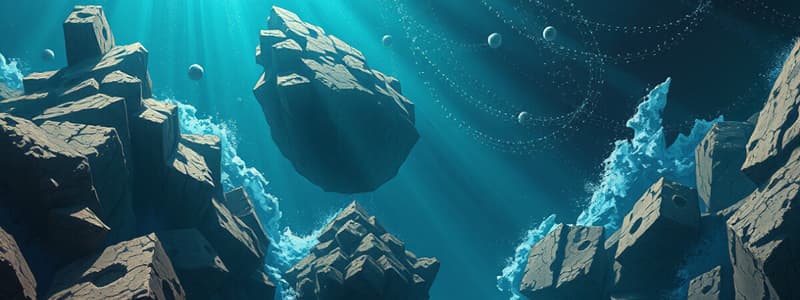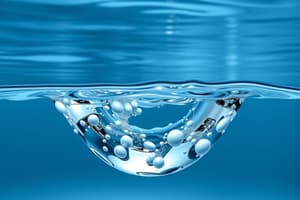Podcast
Questions and Answers
What primarily determines whether an object sinks or floats in a fluid?
What primarily determines whether an object sinks or floats in a fluid?
- The color of the object
- The volume of the object
- The density of the object and fluid (correct)
- The shape of the object
What is the formula for calculating density?
What is the formula for calculating density?
- Density = Mass / Volume (correct)
- Density = Volume / Mass
- Density = Mass - Volume
- Density = Volume + Mass
What happens to energy when a moving object stops moving?
What happens to energy when a moving object stops moving?
- Potential energy is destroyed.
- Energy is created.
- Kinetic energy becomes potential energy. (correct)
- Energy is converted into heat.
Which process is NOT associated with the change from a liquid to a gas?
Which process is NOT associated with the change from a liquid to a gas?
Which of the following types of energy is associated with motion?
Which of the following types of energy is associated with motion?
If an object has a density greater than the fluid it is in, what will happen?
If an object has a density greater than the fluid it is in, what will happen?
What type of energy transfer occurs during conduction?
What type of energy transfer occurs during conduction?
When solid ice melts, what form of energy is primarily being added?
When solid ice melts, what form of energy is primarily being added?
Which type of energy is stored rather than in motion?
Which type of energy is stored rather than in motion?
What is an example of kinetic energy?
What is an example of kinetic energy?
What is the main characteristic of the gaseous state of matter compared to solid and liquid states?
What is the main characteristic of the gaseous state of matter compared to solid and liquid states?
What are the first four types of energy generally considered to be?
What are the first four types of energy generally considered to be?
Which method of heat transfer does NOT require a medium?
Which method of heat transfer does NOT require a medium?
What causes thermal energy to transfer during convection?
What causes thermal energy to transfer during convection?
Which of the following correctly distinguishes between kinetic and potential energy?
Which of the following correctly distinguishes between kinetic and potential energy?
Flashcards are hidden until you start studying
Study Notes
Buoyancy and Density
- Buoyancy determines if an object sinks or floats, based on the comparison of the buoyant force and gravitational force.
- Archimedes' Principle is used to assess the buoyant force against the object's weight.
- Density is the mass per unit volume (Density = Mass/Volume).
- An object sinks if its density is greater than the fluid's density; it floats if its density is less.
Energy Types and Definitions
- Energy is the ability to perform work and is divided into two main types: kinetic and potential energy.
- Kinetic energy is energy in motion; potential energy is stored energy.
- There are ten distinct forms of energy:
- Potential: chemical, mechanical, nuclear, gravitational
- Kinetic: light, radiant, sound, motion, thermal, electrical
- Kinetic energy's formula incorporates velocity, emphasizing movement's role in energy presence.
Energy Transfer Mechanisms
- Energy transfer occurs when energy shifts from one form to another, often through work or heat transfer.
- Work done by an applied force alters a system's motion; heat transfer occurs via conduction, convection, or radiation.
- Solar radiation exemplifies energy transfer through electromagnetic waves; boiling water in a kettle shows practical energy change.
States of Matter
- Matter exists in three primary states: solid, liquid, gas.
- Heat transfer (thermal energy) impacts particles' movement: adding heat increases energy, while removing it decreases energy.
- Solid states have the least energy; gases hold the most.
- Changing states involve processes:
- Freezing, condensation, deposition (energy decrease)
- Melting, evaporation, sublimation (energy increase)
- Specific temperatures, like the boiling point of water (212°F/100°C), dictate state changes.
Heat Transfer
- Heat transfer occurs from higher to lower temperature bodies, driven by temperature differences.
- Three methods of heat transfer:
- Conduction: Requires direct contact; most efficient in solids.
- Convection: Involves fluid movement due to density differences; warm fluid rises, cool fluid sinks.
- Radiation: Transfers heat without a medium, reliant on electromagnetic waves and influenced by the body's color.
Studying That Suits You
Use AI to generate personalized quizzes and flashcards to suit your learning preferences.




